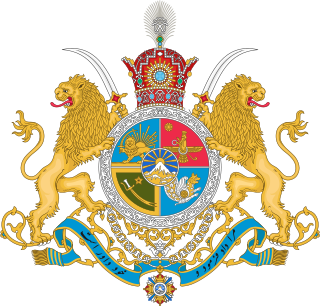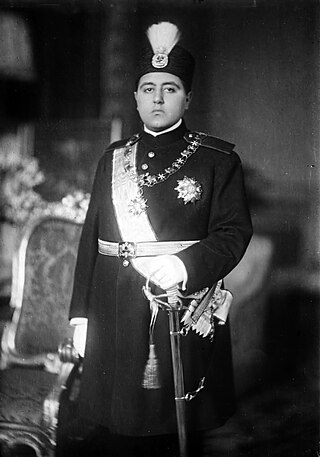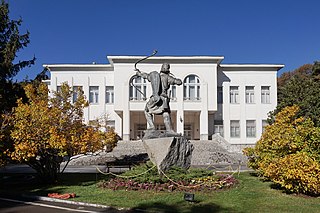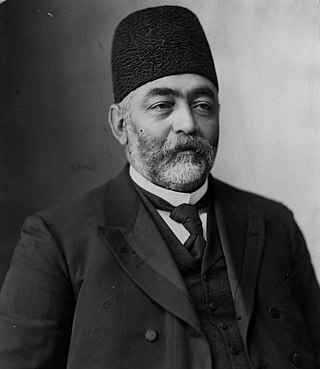This article needs additional citations for verification .(September 2022) |
| |||||
| Decades: | |||||
|---|---|---|---|---|---|
| See also: | Other events of 1925 Years in Iran | ||||
The following lists events that have happened in 1925 in the Qajar dynasty.
This article needs additional citations for verification .(September 2022) |
| |||||
| Decades: | |||||
|---|---|---|---|---|---|
| See also: | Other events of 1925 Years in Iran | ||||
The following lists events that have happened in 1925 in the Qajar dynasty.

Reza Shah Pahlavi was an Iranian military officer and the founder of the Pahlavi dynasty. As a politician, he previously served as minister of war and prime minister of Qajar Iran and subsequently reigned as Shah of Pahlavi Iran from 1925 until he was forced to abdicate after the Anglo-Soviet invasion of Iran in 1941. He was succeeded by his eldest son, Mohammad Reza Shah. A modernizer, Reza Shah clashed with the Shia clergy, but also introduced many social, economic, and political reforms during his reign, ultimately laying the foundation of the modern Iranian State. Therefore, he is regarded by many as the founder of modern Iran.

The Pahlavi dynasty was the last Iranian royal dynasty that ruled for almost 54 years between 1925 and 1979. The dynasty was founded by Reza Shah Pahlavi, a non-aristocratic Mazanderani soldier in modern times, who took on the name of the Pahlavi language spoken in the pre-Islamic Sasanian Empire to strengthen his nationalist credentials.

The Academy of Persian Language and Literature (APLL) is the regulatory body for the Persian language, headquartered in Tehran, Iran. Formerly known as the Academy of Iran, it was founded on May 20, 1935, by the initiative of Reza Shah, the founder of Pahlavi dynasty. The academy acts as the official authority on the language, and contributes to linguistic research on Persian and other languages of Iran.

The Qajar dynasty was an Iranian dynasty founded by Mohammad Khan of the Qoyunlu clan of the Turkoman Qajar tribe.

Ahmad Shah Qajar was the Shah of Persia (Iran) from 16 July 1909 to 15 December 1925, and the last ruling member of the Qajar dynasty.

Agha Mohammad Khan Qajar, also known by his regnal name of Agha Mohammad Shah, was the founder of the Qajar dynasty of Iran, ruling from 1789 to 1797 as Shah. Originally a chieftain of the Quwanlu branch of the Qajar tribe, Agha Mohammad Khan was enthroned as the king of Iran in 1789, but was not officially crowned until March 1796, having deposed Lotf Ali Khan of the Zand dynasty in 1794. Agha Mohammad Khan Qajar was famously the eunuch Monarch, being castrated as a toddler upon his capture by Adel Shah Afshar, and hence was childless. He was assassinated on 17 June 1797, and was succeeded by his nephew, Fath-Ali Shah Qajar.

Fath-Ali Shah Qajar was the second Shah (king) of Qajar Iran. He reigned from 17 June 1797 until his death on 24 October 1834. His reign saw the irrevocable ceding of Iran's northern territories in the Caucasus, comprising what is nowadays Georgia, Dagestan, Azerbaijan, and Armenia, to the Russian Empire following the Russo-Persian Wars of 1804–1813 and 1826–1828 and the resulting treaties of Gulistan and Turkmenchay. Historian Joseph M. Upton says that he "is famous among Iranians for three things: his exceptionally long beard, his wasp-like waist, and his progeny."

The Sa'dabad Complex is a 80 hectare complex built by the Qajar and Pahlavi monarchs, located in Shemiran, Greater Tehran, Iran. Today, the official residence of the President of Iran is located adjacent to the complex.

The prime minister of Iran was a political post that had existed in Iran (Persia) during much of the 20th century. It began in 1906 during the Qajar dynasty and into the start of the Pahlavi dynasty in 1923 and into the 1979 Iranian Revolution before being abolished in 1989.

The Shāh Abdol-Azīm Shrine, also known as Shabdolazim, located in Rey, Iran, contains the tomb of ‘Abdul ‘Adhīm ibn ‘Abdillāh al-Hasanī. Shah Abdol Azim was a fifth generation descendant of Hasan ibn ‘Alī and a companion of Muhammad al-Taqī. He was entombed here after his death in the 9th century.

Mohammad Hassan Mirza Qajar was a younger brother of the last Qajar Shah of Iran Ahmad Shah Qajar, and former Crown Prince of the Qajar dynasty. Soon after Reza Shah deposed the Qajar dynasty and installed himself as Shah of Iran in 1925, Mohammad Hassan and his family were sent into permanent exile to England. In 1930, he declared himself the rightful heir to the crown as pretender to the throne. He died on 7 January 1943 in Maidenhead, England and was buried in Kerbala, Iraq.

Mohammad Ali Foroughi, also known as Zoka-ol-Molk, was an Iranian politician, writer, freemason,, Azali, and diplomat who served as the Prime Minister of Iran for three terms. He wrote numerous books on ancient Iranian history and is known for founding the Academy of Iran.

Reza-Qoli Khan Hedayat was an Iranian literary historian, administrator, and poet in 19th-century Qajar Iran.

Abdol-Hossein Farman-Farma was a prominent Iranian prince in the Qajar dynasty and one most influential Iranian politicians in the Qajar era. Born in Tehran to Prince Nosrat Dowleh Firouz in 1857, he was the 16th grandson of the Qajar crown prince Abbas Mirza. He fathered 26 sons and 13 daughters by 8 wives. He lived to see four sons of his first wife die within his lifetime.

The Shrine of Fatima Masumeh is located in Qom, which is considered by Twelver Shia Muslims to be the second most sacred city in Iran after Mashhad.

Mirza Ali Asghar Khan, also known by his honorific titles of Amin al-Soltan and Atabak, served as Prime Minister of Iran from 1887 to 1896 under Nasereddin Shah, from 1898 to 1904 under Mozaffareddin Shah and from May 1907 until his assassination in August 1907 under Moahammad Ali Shah.

The Guarded Domains of Iran, commonly called Qajar Iran, Qajar Persia or the Qajar Empire, was the Iranian state under the rule of the Qajar dynasty, which was of Turkic origin, specifically from the Qajar tribe, from 1789 to 1925. The Qajar family took full control of Iran in 1794, deposing Lotf 'Ali Khan, the last Shah of the Zand dynasty, and re-asserted Iranian sovereignty over large parts of the Caucasus. In 1796, Agha Mohammad Khan Qajar seized Mashhad with ease, putting an end to the Afsharid dynasty. He was formally crowned as Shah after his punitive campaign against Iran's Georgian subjects.
The following lists events that have happened in 1907 in the Qajar dynasty.

The Iranian Enlightenment, sometimes called the first generation of intellectual movements in Iran, brought new ideas into traditional Iranian society from the mid-nineteenth to the early twentieth century. During the rule of the Qajar dynasty, and especially after the defeat of Iran in its war with the Russian Empire, cultural exchanges led to the formation of new ideas among the educated class of Iran.The establishment of Dar ul-Fonun, the first modern university in Iran and the arrival of foreign professors, caused the thoughts of European thinkers to enter Iran, followed by the first signs of enlightenment and intellectual movements in Iran.

Abdollah Mirza Qajar was an Iranian prince (shahzadeh) of the Qajar dynasty, the 11th son of Fath-Ali Shah, king of Qajar Iran from 1797 to 1834. Abdollah was the governor of Zanjan. He had two children, Mohsen Mirza and Shams al-Molok, with his wife. Other than that, he had 19 sons and 9 daughters from his concubines.